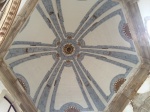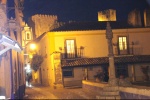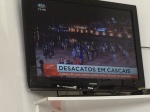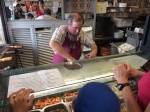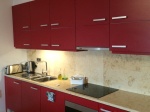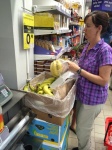Everyone please settle in and grab a coffee because this is a long one. After almost three months away with the whole family we have a lot on which to reflect. Much comes to mind as you travel around on an experience like this and after being back a couple of days (and finally sleeping in!) it kind of all pours out. As with Bagamoyo, some of it is more serious (or interesting perhaps) than others but hopefully you enjoy some things in this stream of consciousness in what will be our last post. For those of you checking in from Lake Junaluska (you have WiFi now – wow!), we hope it makes for some good porch reading. We miss you.
The final morning in Lisbon had us completing our packing for the last time. This was done strategically – putting all of our special treasures in carry-on and many of those items that were oh-so important earlier in the trip such as medications, the zip off pants and the down-filled coats could now be put into checked baggage. Otherwise, this was our 19th flight and 28th place of accommodation on the trip so we were pretty good at packing.
The flight went fine except you really miss those little TVs on the back of your seat when you don’t have them especially for 8 hours of flying. We had to have some serious iPad battery management as a result although we were pretty good at that too by now (Liz had thoughtfully bought back-up batteries that could recharge in an emergency that often came in handy). The flight was longer than expected because we ended up with a stop in the Azores and had to get out of the plane. This had the advantage of officially adding another country to our list (well, it’s an “autonomous region” at least) which made it 12 (9 planned + we stood in Mozambique briefly + we had that connection in South Africa + now the Azores = 12. Does the West Bank count? Don’t want to get into that.) The other benefit was Abby and David getting to hang out with some other kids from Toronto while waiting at the gate. This included a potential love interest for David (she’s pretty cute eh?) and a potential babysitting gig for Abby (she really draws the little children).Once we touched down safe and sound we picked up our checked bags one final time and reflected that we didn’t have a single problem with lost baggage on any of the 19 flights. We did spend a fair bit of time worrying about that before and during the trip. During the trip, as mentioned above, we packed the backpacks strategically whenever we were taking a flight. It was interesting how what we determined to be critical (and therefore made it to the backpack) changed as the trip went on. In particular, once we hit Morocco, “cold weather clothes” were not so important. Before we left, we “practice packed” a month in advance to see if there was a way to travel for almost three months with only carry-on bags (as we normally have done when traveling but for a much shorter duration). We determined that it might have been possible but would leave virtually no room for stuff we pick-up along the way and the technically carry-on sized bags might not be acceptable to the airline anyway. This pretty much turned out to be the case as we almost always ended up checking everything other than our backpacks. In the end it all worked out although Pearson may have been the longest wait to get our bags on the whole trip.
Milt (Jim’s dad) was a welcome sight when he picked us up at the airport and brought us home. That was a treat rather than hopping in another cab. Once home our nanny Miriam was also here to greet us because, as you may recall from the very first post, she stayed in the house all summer to take care of it. It was wonderful to return home and share the experience with them. Jet lag was not a factor as the kids in particular were so excited to be home. They showed Milt and Miriam famous souvenirs like the knife that had been sharpened by real Masai and the beautiful African dresses from Bagamoyo (David and Abby respectively, to be clear). There was also a lot of reconnecting with our “things” like putting on a pair of jeans (we didn’t pack any – too heavy and not versatile), drinking water from the tap and enjoying the home cooked meal that Thelma dropped off. Abby decorated her room to look like a souk and David wrapped himself up in his pile of stuffies at bedtime.
We reflected on what we were most looking forward to and not looking forward to once we got home. This was the result:
Liz: Looking forward to – drinking tap water, changing clothes and seeing the cats (funny that everyone had this but Jim). Not looking forward to – getting back to the reality and crazy busy-ness.
Jim: Looking forward to – having another 2 weeks for the sabbatical in order to go see those struggling Jays, go up to Midland canoeing, go golfing, see friends and generally ease back into things. Not looking forward to – going through work email and getting underfoot as the more daily routine kicks in around the house next week.
Abby: Looking forward to – reading paper books, talking to friends, watching Dr. Who, not using a suitcase and seeing the cats. Not looking forward to – missing Lake Junaluska. We miss you and wish we could be there but we are adjusting back to the realities of home and, in another thing Abby is not looking forward to, getting ready to go back to school on Tuesday (including the related tragedies of starting 8th grade and doing homework). This includes the normal back-to-school clothes shopping but also re-connecting with school chums to hear the summer gossip before school starts. We look forward to a FaceTime and Abby really looks forward to seeing Emma. She may have a special thing or two for her.
David: Looking forward to – talking to his friends and having a back-to-back sleepover (not sure that’s possible over a long weekend but we’ll try). Also, going to the park, playing with the cats and not moving around every day. Not looking forward to – also, going back to you-know-what (we’re not allowed to use the “s” word around here this weekend) and having a new teacher.
We also spent some time on the plane having a final session of our highs and lows. You may recall from earlier posts that every day at dinner we took turns describing our high points and low points from the day, this is a family routine that we have done since the kids were 3 and 5. We thought it fitting to do that for the whole trip although we had to do it in several categories to try and break it down a bit. It kind of goes from high level to lower level. Here they are:
High and low country – no one had any truly low country (other than Jim with Dubai) so this is kind of a relative measure. Also, everyone’s second choice would be Tanzania (Bagamoyo). The experience was amazing all around but it was drawn out over two weeks and didn’t have that one signature moment as with some others. Anyway, here is the list (with some editorial content in parentheses):
Mom: High (H) – Zambia (most interesting animals and tracking), Low (L) – Dubai (culturally uninteresting).
Dad: H – Israel (remarkable sights and mix of culture), L – Dubai (see the blog on this one).
Abby: H – Morocco (because it was relaxing), L – Israel (religion great but guys and tours made “her head explode”).
David: H – Dubai (shopping outside of a souk), L – Portugal (too much walking).
High and low guide: similarly with the countries, we didn’t dislike any of our guides. They were all very professional and had a huge knowledge base. The stand-outs were the ones who could make it interesting for the kids. We split it between safari guides and regular guides:
Mom: Safari H – Kyle, Sausage Tree (shocking). Regular H – Hannah, Bagamoyo (she gave us the real inside scoop) and Issac, Malawi (he was informative). Safari L – Mcleod, Mvuu Lodge Malawi (although he could be tainted by the lack of additional wildlife in the park overall). Regular L – Wally, Jordan (was loud, interrupted and didn’t follow through on a number of things including the sand boarding in the desert).
Dad: Safari H – Bwallia, Flat Dogs (all business and he spit that giraffe poo). Regular H – Issac, Malawi (he spoke when he had something interesting to say otherwise he didn’t) with an honourable mention to Paula in Lisbon. Safari L – Sammy in the Masai Mara (he wasn’t very colourful). Regular L – Driss, Morocco, or, if you could consider Hakim in Morocco a guide, then him.
Abby: Safari H – Q, Kenya (she played cards with us and engaged with the kids the best). Regular H – Hannah, Bagamoyo. Safari L – McLeoad, Mvuu Lodge. Regular L – Wally, Jordan.
David: Safari H – Kyle, Sausage Tree. Regular H – Issac. Safari L – John, Kenya (but he was more of a driver so can be forgiven – he also spotted the rhino). Regular L – Yuval, Israel (he was good with the kids but could be a little harsh) and Mustafa, High Atlas Mountains (he says to go slow but goes fast).
High and low day: in a trip like this you are of course going to have a lot of “up” days and some “down” days. We thought we would try and capture some of them (multiple answers were allowed for this one). A “day” could also be interpreted to be an event or activity (basically this was wide open). Everyone scored the amazing Wildebeest migration as a high so we won’t repeat that each time.
Mom: H – Mule ride to Prophet Aaron’s tomb (she did better with these mules than on the way up to the Kasbah in the mountains. Despite the many generous offers to contribute to the kids education fund, we still can’t get that video released), the walk in the Tea estates with the kids, any day we saw an elephant (you know how Liz loves her elephants) and meeting the Masai. L – seeing all of the poverty as well as the litter everywhere, the drive to Mvuu lodge (it was long and uncomfortable in Issac’s car (his one downside)), seeing dead animals such as during the Wildebeest migration and the jackal chasing the baby antelope.
Dad: H – Old Jerusalem, spotting the cheetah, seeing the rhino L – throwing up in Bagamoyo, the restaurant in Dubai, the carriage ride at Petra (the driver was a jerk) and also Liz’s re. the litter and poverty.
Abby: H – the entire day in the Masai with the Wildebeest (with guide Tim who could have been a top guide), any of the days at the Dead Sea and Lisbon (except the aquarium). L – the aquarium in Lisbon (as noted in the blog, she doesn’t like aquariums for some reason) and the hike up to the monastery in Petra (where her “brain exploded because of the heat”).
David: H – visiting where Jesus was put on the cross, seeing the rhino and meeting the Masai warriors. L – the mountain hike in Morocco, all the walking in Portugal and, apparently, everybody yelling at him when we were at Danforth Yachting (no one actually remembers yelling at him but we’re sure he took whatever the incident was that way and we’re sorry).
Next and in addition to the above, we tried to narrow it down to the high safari/animal sighting. We didn’t do lows because aside from a few dead animals and the fact that we didn’t see a complete kill (including crocodiles eating any wildebeest during the migration (this was David’s – he says we were promised but no one remembers it being that strong a commitment)), there weren’t really any lows in animal sightings.
Mom: the elephant chewing right outside our tent at night in Mvuu camp, the hippos in the river in front of us at Sausage Tree and the monkeys at Flat Dogs that David battled with a sling shot.
Dad: the rhino and cheetah.
Abby: monkeys in the garbage cans.
David: chasing monkeys with his Masai hammer in the camp in Kenya.
It’s interesting how much of this was the unplanned interactions versus the formal game drives.
Lastly we talked about our high and lows in terms of accommodation. The highs were hard because we had lots of really good accommodation. We tip our caps to Quench Travel here. We told them right up front that we wanted decent accommodation but not “Five Star” – we wanted to experience the place that we were visiting (not to mention keep the costs down (which by the way, we will never finally tally)). We’d say they really delivered in giving us a variety of amazing experiences but we tried to narrow done the highs and lows anyway.
Mom: H- Sausage tree, Flat dogs (remember that amazing tree house?). L – Kenya hotel (this was given to us because we were “special” but it was the closest we came to getting malaria), Wadi Rum tent (it was hot!).
Dad: H – the tower in the castle in Obidos, Portugal (like going back in time), that Flat Dogs tree house and the riad in Marrakech. L – Bagamoyo (see the blog for the list of “experiences”), the noise in Essaouira.
Abby: H – the castle in Portugal, the Lisbon apartment (even though it appears she got attacked by bed bugs in her cot or spiders, we aren’t sure which). L – Bagamoyo
David: H – apartment in Essaouira (because he got his own room). L – Bagamoyo
We thought of many more potential categories but these seem the meatiest. If you think we’ve missed something interesting, please comment and we’ll reply. One loose end is the result of the Santini’s ice cream eating (we did manage to try all 25 flavours). The clear winner was strawberry with honourable mentions to any of the berries because they use fresh fruit. Mostly though it was an excuse to eat a lot of ice cream.
We began to unpack our stuff and also reflected on how well we did with the packing.
As you can imagine, trying to pack for almost three months while traveling to 9 countries means you have to be prepared for just about everything while also trying to pack light. Generally, we got it pretty much right but here are a few highlights that could also double as travel tips (or advertising):
Icebreaker T-shirts. These are made with New Zealand wool and were advertised to be quick drying and cool in the hot and warm in the cold. This turned out to be exactly right. We highly recommend them although they are pricey. We brought other cotton-type shirts and it was striking to feel the difference.
Zip off pants. We didn’t bring any other pants and they proved invaluable. As we mentioned when we talked about the weather in a previous blog, everywhere we went in southern and east Africa started out chilly in the mornings and got hot through the day. Being able to zip down to shorts was wonderful. They also served well enough as pants when we needed to dress at least a little bit fancier (except for that place in Dubai – not over it yet!).
Cold weather gear. Liz and Jim learned their lesson in Tanzania 13 years ago and in Peru last year – prepare for the cold. We had Patagonia down-filled jackets that were super light and folded up into a little ball into itself, we had lightweight fleeces that we wore to practically threadbare on this trip, we had fancy wool hiking socks that were like the Icebreaker shirts in that they were warm but also breathable and we had good broken in hiking boots. Jim went a little overboard and brought long johns as well as bought a toque and mitts on our layover in South Africa. Don’t laugh, he used them. There were times in the mornings when you could see your breath especially early on in Zambia. It took a couple of painful travel experiences but we learned and were well prepared for the weather.
Toiletries. It’s hard to estimate how much you’re going to need of various lotions, creams, prescription medicine, etc. You also don’t want to count on being able to get some of that stuff while you’re away. So, again, we practiced with the little travel sized items in the month or two before we left and did well. Generally, in the end, we were able to re-stock pretty good along the way and we undoubtedly used way less “product” in the places we traveled. The only real hiccup we had was looking for “Muzungo shampoo” in Bagamoyo. It appears they wash their hair with soap. We ended up happening upon someone selling “Muzungo shampoo” along with 5 other or so products on the side of a dirt road. We were never so happy to have a bottle Head and Shoulders. No high end products here!
Luggage. We looked around a long time at various luggage options and got it about right. We tried the big backpacks last year in Peru but we’re not 25 anymore and given we had transport almost all the time, we thought something that rolls would be better. We got a cross between a backpack and a rolling bag from Eagle Creek and they stood up really well. As we also mentioned in a previous blog, they were probably about the right size as well. Things like the big pile of malaria medication shrunk as we progressed but we added things like the Bagamoyo carvings and paintings and had enough room.
“Luxury items”. We packed two luxury items that proved extremely valuable – the bluetooth keyboard (as discussed in a previous blog) and his coffee kettle and related supplies (including instant coffee, a mini spoon and a little cup). We questioned before we left how many of our stops would have convenient coffee facilities and the answer was very few. This was particularly important because most of the blogs were done early in the morning before getting on with our day so coffee was key! As for the keyboard, Jim used it most of the time but Liz liked it for emailing too. We’ll also give honourable mention to the iPad Mini which was definitely small, light and versatile and to our iPad covers that we shopped quite a bit for too. Liz and the kids had ones made of bamboo that looked like books and held up well (with a little mending for Abby’s in Malawi). Jim practiced with several but landed on one that held the iPad in all kinds of angles, etc. which turned out to be excellent for the blog which was done in many odd places and spaces. There were also those back-up batteries that proved useful many times as mentioned but something we could have used from time-to-time was a car charger.
Medication and first aid. Liz took care of this before we left and got it all right. As you might imagine, there are a bunch of prescription and non-prescription things that you need to bring and it is far less likely that you can get these while on the road. We had just enough malaria medication (and nobody appears to have gotten malaria) and the cypro came in handy for the stomach bug that made its way through three of us in Morocco. We had lots of other first aid that luckily we didn’t need but we were well prepared.
Shoes. Isn’t it always difficult to know how many shoes to pack? Try figuring it out for three months. We knew we needed hiking boots and as mentioned we had ones broken in from Peru last year. We also knew we needed something for the beach so we all brought a form of sandal or flip flop. The question was something in-between like tennis/running shoes. The answer was in something produced by Merrell. They make a shoe that is sturdy like a running shoe but they are really light and can also be used in the water. They were perfect and made it in the backpack every time.
Jim’s backpack. One of the last things that Jim bought was his backpack. He wanted something light and portable but that could carry a fair bit and he tried out several before leaving. In what was about the worst impulse buy of the trip, he finally landed on one in the bargain bin at the CAA when we were getting our international drivers licenses a couple of days before we left. It had initial promise but ripped around the straps within the first couple of days. He underestimated how much we would use the backpack in addition to Liz’s and fully expected it to fall apart and need to be replaced en route where possible. Somehow though the key part of whatever attaches the bag to the strap managed to hold and we made it home. Lesson learned – don’t cheap out on the backpack!
The cameras. Liz’s Canon proved itself last year in Peru and was tried and true on this trip as well. The best pictures on the blog were definitely from this camera. We were taught how to download pictures from it to the iPad in a lesson we took at the Apple Store before leaving and the little attachment that was necessary was invaluable (recall being in the Apple Store in Tel Aviv with Yuval when we lost it in Israel – we kept a close eye on it for the rest of the trip). Jim’s Sony video camera was another item we added late in the packing process (it may have been the last thing bought). We had a video camera from several years ago but we’re glad we got up-to-date. It was very light, had huge memory capacity, you could extract a picture from a video (most of the real “action shots” were done this way) and, as discussed in the video blog, you could get smaller sized pictures and video out of it through built-in WiFi. Jim shed a little tear when he pulled the last picture from it yesterday.
Now that we’ve been back a couple of days, everything seems a bit too easy. It’s great to turn on the water and drink out of the tap. It’s great to push a button on the automatic coffee machine and get coffee. It’s great to come downstairs, turn on a light and have entire other rooms in which to do your thing in the morning. It’s great to see cats that aren’t strays. It’s great to have a TV and, better yet, one that’s in English.
You no longer have to ask questions like can you drink the water? Is there electricity? Where are the light switches and plugs and what kind of plug? Is there WiFi? What’s the code and is it fast? Where is breakfast? What’s the exchange rate? When you arrive home, you still have this strange feeling like you should need to figure this all out and it feels odd that it all comes naturally, automatically. But it’s all these things that stay with you and call you back. And, as we said many times, the challenges associated with all these things while we were away are “all part of the adventure”. For example, the wonder as you come into a new place and the thrill when you find something you’re looking for. The joy of a local dish that turns out to be really good. The ease you feel after making it into a nice apartment you booked but hadn’t seen. The exhilaration of getting a nice comment about your blog that you wrote at 5 am. The fun of chatting with others that you randomly meet along the way about your collective experiences. The awe as you turn the corner and there it is: where Jesus was born and died, the Treasury at Petra, Victoria Falls, a small plane taking you to the bush, a lion/rhino/cheetah/leopard/elephant, a one-room school house where you’re called “Teacher You”, a beautiful lake, a Masai warrior, Wildebeest migrating, a snake charmer, a cathedral, a mountain/desert/water view, a sunset (or sunrise), a desert, a nice (or not so nice) bathroom, people crawling on their knees to a chapel, a castle, a beach… it goes on and on.
This caused us to reflect back on the original blog post which kind of set out our expectations for the whole trip. Here’s how we did:
We wondered about the WiFi connections to do blog posts and otherwise stay in touch with life back home. We commented on that many times during the trip and while it was hit and miss, it generally amazed us at the prevalence of WiFi throughout even the poorest countries.
We prayed for sun especially during our rest stops. As we know, this turned out fantastic with great weather throughout. Much of our time was spent outside of “high season” for most of the places we went which surprised us because we felt we went at the best time. It was cool at night for sleeping (we hardly ever had air conditioning) and hot in the day. Sure, swimming was cold at times but we’d sacrifice that for the sleeping conditions. The one or two hot nights we had were in the desert which made for a somewhat bleary-eyed day following.
We wondered about the parasite in Lake Malawi. And we still wonder about that but we have our medicine and will take it in a couple of months. We still feel that we took reasonable precautions while enjoying our experience.
We indicated that we would be teaching English in Bagamoyo. In turned out that we taught just about everything without knowing much about the curriculum but we also learned a lot from them as well. As Garry Newton said about Africa in a comment on the blog (who has the most experience of any of us) “AHHHHHHHHHHH Africa, interesting, captivating, complicated, sad, beautiful, abandoned. Enjoy and learn.” That pretty much sums it up.
We said that we would be going on a family group safari in Kenya. This was probably the most disappointing bump in the road (pun intended). We’ve ranted about this already so no need to repeat here but as we discussed above, some of our best experiences were in Kenya.
We said that we were looking forward to the shopping malls, pools, tall buildings and beautiful beaches on very hot days in Dubai. And we were and it was hot – very hot. The overall result was very mixed however – for some of us it was one of our favourites, for others clearly the worst. To each his or her own.
We indicated that we would have a “couple of days” hiking in the High Atlas Mountains. We cut that short didn’t we?
We thought that we would be “exhausted but fulfilled” after our driving tour around Portugal. And we were. We enjoyed pretty much everything about the whole trip including our planned tours with guides but we were also glad to have the opportunity, as we said “to get back to our travel roots” and strike out on our own. Making the mistakes and wrong turns, shopping in the grocery stores and cooking your own food is fun too (when in a safe environment).
We said that we would make improvements to the blog as we went. And we did although the layout and general format stayed pretty consistent. We enjoyed getting into a new country and speculating on what that country’s header picture would be. We liked adding the video but think that it didn’t have as a big an impact as we thought it might. We liked doing the polls but didn’t see too many opportunities to use it (BTW, the beard stayed on – sadly!!!!! (Liz edit)). The menus seemed to be helpful. In general it seems that everyone enjoyed words and pictures and we enjoyed doing it. Our next-to-final stats for the blog are: 57 posts, over 38,000 views from 21 countries, best ever day was 1,509 views (the High Atlas Mountains) and we had 216 comments. We thank all of you very much for that. Without your encouragement, it would have been difficult to keep it up.
We hoped that no emergency visits would be necessary to our home in TO by Milt (as was the case last year when we were gone to Peru). And none were necessary. However, we thank him for dropping by and starting the cars and checking on things and we thank Miriam for staying here and looking after things as well. We couldn’t have done this without their support.
In general, things tracked very well compared to our itinerary and we’d like to thank Quench Travel (Mercedeh, Hannah, Jenn, among others) for their flawless execution. Obviously this was a big trip and we have traveled a fair bit before and it’s possible, just possible, that we were a pain in the ass at times. We thank Quench for their patience and professionalism in these moments and throughout and encourage anyone looking to do a trip – big or small – to contact them. We will encourage other sabbatical-goers to do just that.
A few other thank yous we’d like to post. First, to Hannah and crew in Bagamoyo, thanks for a wonderful stay. We’ll never forget it. We’d like to again thank Quench and all of our guides and related tour companies who were amazingly coordinated and professional. We’d like to thank the people of the countries we visited who welcomed us warmly. And we’d like thank each other, Liz for being the primary organizer and guide, Jim for being the bloggist, the kids for their youthful enthusiasm and course corrections where necessary and everyone for their patience.
The reality that it’s over set in differently for Liz and Jim. For Liz, she was on the plane listening to Paul Simon’s “Homeless” which has Masai-like grunts in the background. This drew tears. For Jim, it was seeing things that remind you of the excitement of going. The front hall where we lined up our bags before leaving and the bedroom where the list of items to pack was still lying with the last few things that we decided not to take. You long for that excitement again. But, inevitably, it’s back to the routines: there is a baseball practice tonight, Scouts and Girl Guides start up, Jim has a work function to say goodbye to a friend (sigh), we have to check those report cards for the first time (they turned out good), shop for back-to-school clothes and prepare mentally for the first day. There is a huge stack of mail to go through, emails to clear, pictures to organize, etc. etc.
And so it is time, with a heavy heart and a little tear in the eye, to post the last blog for thenewtonsinafrica2014. Good, safe travels to you all, until next time…















































































































































